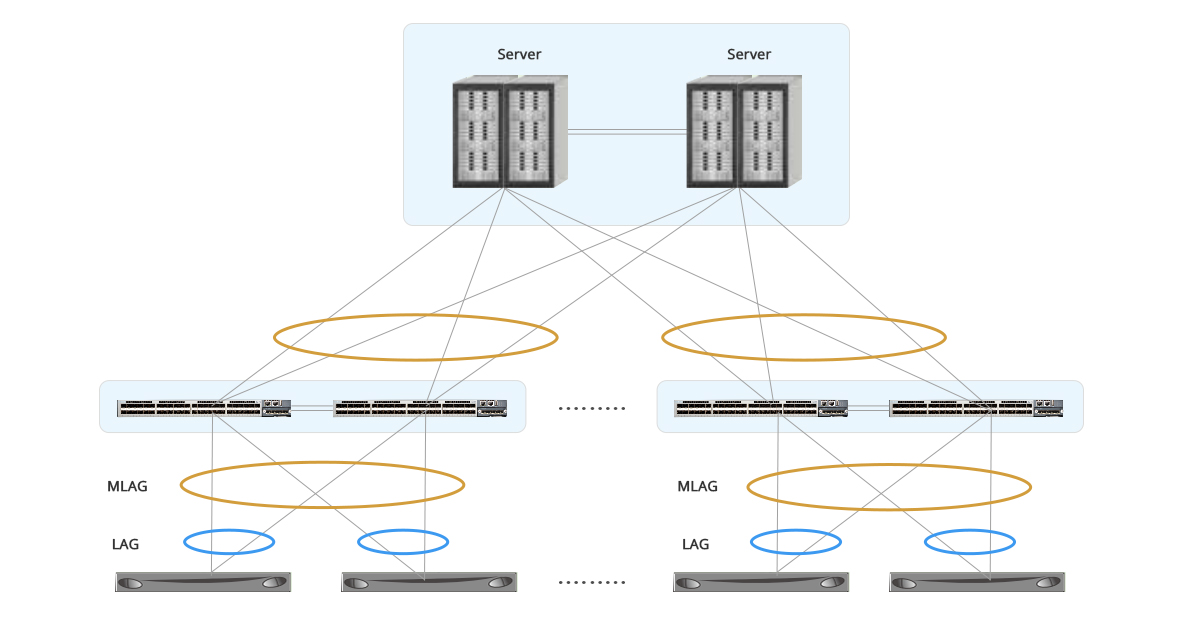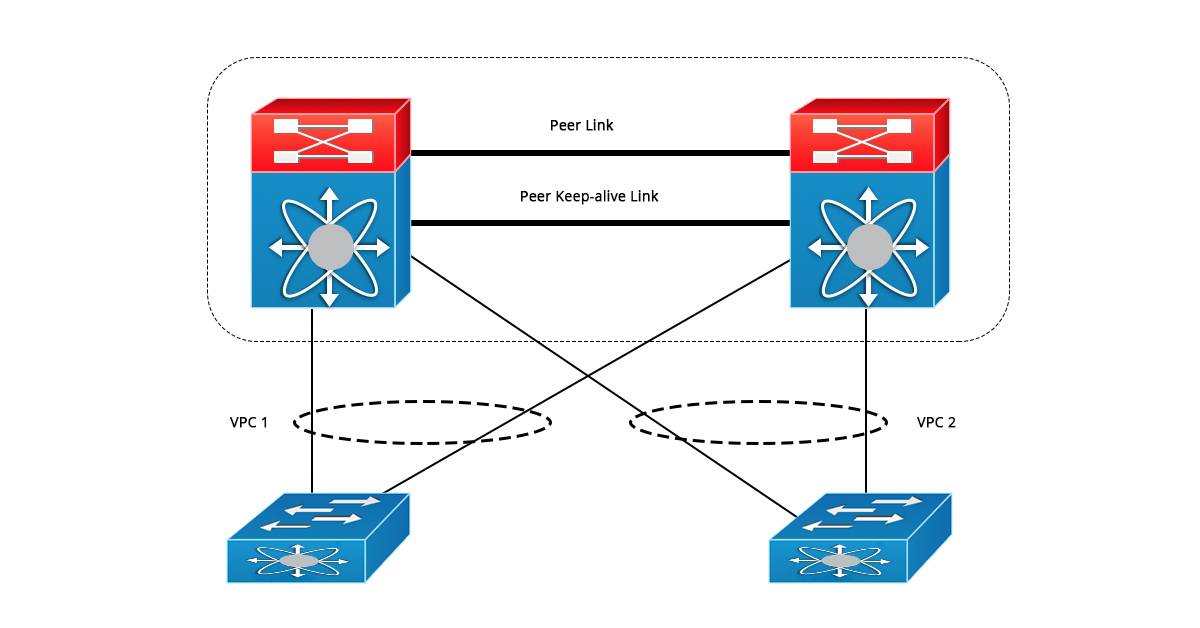MLAG vs VPC
As more enterprises begin to utilize data center virtualization to cut costs and streamline data flows, the demand for more network bandwidths increases substantially to ensure that data can be transferred seamlessly between the data center and business locations. To cater for this trend, network engineers are seeking ways to connect as many networking devices as they can to enhance network bandwidth. And link aggregation group(LAG) is one of the ways to do that, LAG can parallelly combine multiple Ethernet links into a single logical link, and it improves data transmission efficiency. There are many ways to create LAG, including MLAG and VPC. So, what do MLAG and VPC mean and how do they differ from each other? This post will give an overall explanation for each of them, and make a proper decision over MLAG vs VPC.
What Is MLAG?
MLAG (Multi-chassis Link Aggregation) is a non-standard protocol that enables Layer 2 multipathing from the host to gain either additional bandwidth or link resiliency. It’s a public protocol so that every vendor can support MLAG by using their own custom rolled implementation of it. Like Stacking, MLAG is the ability of two or more switches to act like a single switch when forming link bundles. It allows a host to uplink to two switches for physical diversity, while still having only one single bundle interface to manage. In turn, these two switches can connect to two other switches using MLAG, with all links forwarding. Watch the following video to learn how to configure MLAG on S5800-8TF12S hyper converged infrastructure switches.
In MLAG links, Link Aggregation Control Protocol (LACP, 802.3ad) is typically used to negotiate north and south between host and an MLAG virtual switch or between MLAG virtual switches. East and west proprietary protocols are used between switches that are members of the same MLAG virtual switch. Figure 1 shows the example of using multiple S5850-48T4Q gigabit ethernet switches to form an MLAG Pair. With four leaf switches in an MLAG pair, you can build redundant connections from the server to the switches. The LAG groups can be formed using static link aggregation or LACP based negotiation methods.
Benefits of MLAG
After understanding the working principle of MLAG, we can clearly know its advantages in use.
- Traffic is evenly distributed to each of the switches through the use of LAG hashing.
- Simply bundle more links into the LAG to increase bandwidth for North & South as well as East & West
- Offers stability with dual management and control planes
- Able to upgrade one switch at a time without affecting other devices
- Expands port capacity freely–simply adding another switch East or West by creating another MLAG to another switch
What Is VPC?
VPC is short for Virtual Port Channel where a Port Channel is a regular LAG. (A Port-Channel is a technology that provides a way to aggregate (bond) multiple interfaces together. Traffic is then loadbalanced across each of the connections.) It is a Cisco Nexus specific protocol that is hard to configure on any other type of switch. Of course, there are indeed VPC-enabled switches offered by other vendors except Cisco, but not too much. VPCs allow links physically connected with two different Cisco switches to appear as a single Port Channel to a third device. The third device can be a switch, a server, or any other networking device supporting IEEE 802.3ad Port Channels. VPC also allows the creation of Layer 2 Port Channels that span two switches. As illustrated below, VPC is utilized to create inter-switch links spanning two switches while keeping two control planes of these switches separate. After you enable the VPC function, you create a peer keep-alive link, which sends heartbeat messages between the two VPC peer devices. The VPC domain includes VPC peer devices, the VPC peer keep-alive link, the vPC peer link, and all the Port Channels in the VPC domain connected to the downstream device. You can have only one VPC domain ID on each device.
Benefits of VPC
As Cisco’s specific protocol, VPC will certainly have its own unique advantages.
- Allows a single device to use a Port Channel across two upstream devices
- Eliminates Spanning Tree Protocol blocked ports
- Provides a loop-free topology
- Uses all available uplink bandwidth
- Provides fast convergence if either the link or a device fails
- Provides link-level resiliency
- Helps ensure high availability
MLAG vs VPC: What’s the Difference
Both MLAG and VPC are aimed to create a port group between two switches and could enable Layer 2 multipathing. In MLAG or VPC domain, each switch is managed and configured independently and able to forward/route traffic without passing to a master switch. What are their differences? Obviously, the biggest difference between them is the difficulty of implementation. MLAG is a public protocol which could be supported by almost every vendor using their own custom rolled implementation, while VPC is a Cisco Nexus specific protocol, not all the vendors could have this technology in hand. Thus, MLAG setup is a bit easier than VPC. Network engineers who want to deploy VPC should study vendor’s scenario-driven VPC design guides before building a VPC domain. For VPC pairing, the same type of Cisco Nexus switches must be used. For example, it is not possible to configure VPC on a pair of switches including a Nexus 7000 series and a Nexus 5000 series switch. And the VPC peers must run the same NX-OS version except during the non-disruptive upgrade, that is, In-Service Software Upgrade (ISSU). Besides, the VPC peer link must consist of at least two 10G Ethernet ports in dedicated mode. VPC is more advanced than MLAG. It supports both Layer 2 and Layer 3 multipathing, which allows you to create redundancy by enabling multiple parallel paths between nodes and load-balancing traffic where alternative paths exist. And if you want to enable Layer 3 multipathing, you could also use the Multi-Active Gateway Protocol (MAGP). Normally, VPC is used for data center (nexus devices running either NX-OS or ACI mode) switches, while MLAG could be used for more scenarios mostly in distribution or data center switches.
Conclusion
Both MLAG and VPC are desirable implementations for data centers and cloud computing networks that require the highest level of network bandwidth and reliability. MLAG takes the benefits of link aggregation and spreads them across a pair of data center switches to deliver system level redundancy as well as network level resiliency. And VPC is more suited to achieve non-blocking path diversity where virtual machines might reside at any given point. No matter which method you are deciding between MLAG vs VPC, the foremost thing is to make clear whether your networking devices can support MLAG or VPC. Then take account of the fabric architectures and your own specific traffic requirements before implementing a certain connection method.
Source: community.fs
Related products...
fiber-optic-cable
DRAKA fiber optic cable 24 core (1*24), singlemode Armored-Out
fiber-optic-cable
AMP fiber optic cable 12 core (1*12), multimode OM1, Armored

















[ratings]